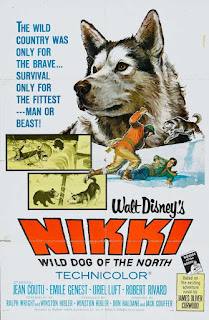
Year Released: 1962
Michael's Movie Grade: B+
History
Naturally with the success the Disney studio was having with live action comedies, due to films like The Shaggy Dog and The Absent Minded Professor, Walt knew that this type of film would become a staple of the studio. However with Bon Voyage the Disney studio decided to try something different. This was a live action Disney comedy, but the humor was not very slapstick based or aimed at kids. This was in fact a Disney comedy that would actually bring up such subjects as loss of virginity and prostitution. While never stated directly this ideas aren't exactly hidden either (conversation about a young girl who had her virtue taken away from her for instance).
This was the second Disney feature directed by James Neilson. His first for the studio was Moon Pilot, which was the Disney theatrical feature right before this. He would later direct Summer Magic, The Moon Spinners and The Adventures of Bullwhip Griffin for the studio. The film was written by Bill Walsh, who had previously written the Disney films The Littlest Outlaw, The Shaggy Dog, Toby Tyler and The Absent Minded Professor. He would later write a little film for Disney called Mary Poppins.
The cast should be very familiar to fans of Disney films from this era. Fred MacMurray had previously been in The Shaggy Dog and The Absent Minded Professor, and would later be in Son of Flubber, Follow Me Boys and The Happiest Millionaire. Tommy Kirk and Kevin "Moochie" Corcoran once again play brothers here as they had in Old Yeller, The Shaggy Dog and Swiss Family Robinson. They would again play brothers in Savage Sam. Jane Wyman has her second and last role in a Disney film here (she was in Pollyanna earlier). This is Deborah Walley's second feature film (her first was Gidget Goes Hawaiian), and her first appearance in a Disney film, she later appeared in Summer Magic.
Because the movie takes place there much of the film was filmed in Paris, France. This was the first Disney film filmed there. The scenes aboard a cruise ship were filmed on the S.S. United States, a 990 foot long ship and the first ship built almost entirely out of drydock. This ship (which had it's first trip in 1952) can still be seen in Philadelphia.
Critics did not like this movie, they felt it was too long and too boring for smaller audiences, while being too simple for older audiences (If they could only see much of what is being made for older audiences now, but I digress). This however did not stop it from doing well at the box office.
Review
A thoroughly delightful comedy-drama and an excellent film.This is a film full of charm. The main characters are all very likable, the performances from the actors are great, the location shooting is fantastic, there are some quite funny moments, and most importantly the film flows very well as a whole. There are times that this movie can bee a bit episodic, but that works to the film's advantage. At times the movie does just feel like a nice vacation, partly because of this. The romances are believable and you really find yourself actually caring about them. Most of all though the film just has a real pleasantness to it. This is hugely because the film takes it's time and lets us soak in the great sense of atmosphere this movie has.
Though this movie does feature a few risqué moments for a Disney film, they are handled very tastefully. Never does the film descend into vulgarity. There is actually quite a bit of suability especially to a scene involving a prostitute (that is quite funny as well). I will say for those with you kids, they most likely will not get these risqué scenes at all, and will probably be bored by them instead. Adult (and maybe teen) Disney fans, though may find it refreshing considering all the extreme vulgarity you can see in movies today.P
On the downside I think by this time Kevin Corcoran was too old to be playing the type of roles he had played in previous Disney films, and he is playing one here. He plays it well and he does get a few laughs in but he is simply to old for the part. Also there is a scene involving a sewer that goes on too long. However these are minor problems with an excellent movie.
Film Credits
Director: James Neilson
Writer: Bill Walsh
Based off a book by Joseph and Marrijane Hayes
Cast: Fred MacMurray (Harry Willard), Jane Wyman (Katie Willard), Tommy Kirk (Elliott Willard), Deborah Walley (Amy Willard), Kevin Corcoran (Skipper Willard), Michael Callan (Nick O'Mara), Jessie Royce Landis (Countessa DuFresne), Georgette Anys (Madame Clebert), Ivan Desny (Rudolph Hunschak), Françoise Prévost (Girl), Alex Gerry (Horace Bidwell), Howard Smith (Judge Henderson), Max Showalter (Man), James Millhollin (Ship's Liberian), Marcel Hillaire (Sewer Guide), Richard Wattis (Party Guest), Phillip Coolidge (Clerk), Hassan Khayyam (Shamra's Father), Ana Maria Majalca (Shamra), Doris Packer (Mrs. Henderson), Jeffery Sayre (Dancer), Marie Sirago (Florelle Clebert), Sara Taft (Woman), Carol White (Penelope Walthorne)
Producers: Walt Disney Bill Walsh, Ron Miller
Songwriter: Richard and Robert Sherman
Music: Paul Smith, Evelyn Kennedy, Franklyn Marks
Cinematographer: William Snyder
Editor: Cotton Warburton
Art Directors: Carroll Clark, Marvin Aubery Davis
Set Decorators: Emile Kuri, Hal Gausman
Costume Designer: Bill Thomas
Makeup Artist: Pat McNally
Hair Stylist: Ruth Sandifer
French Production Manager: Sacha Kamenka
Assistant Director: Joseph L. McEveety
Sound Artists: Dean Thomas, Robert O. Cook
Effects Artist: Eustace Lycett
Photographer: Frank J. Calabria
Costumers: Chuck Keehne, Gertrude Casey, Joan Joseff
Title Sequence: Bill Justice, Xavier Atencio
|
The Disney Films by Leonard Maltin
http://www.ssusc.org/facts/
http://www.thedisneyfilms.com/search/label/Bon%20Voyage
http://www.imdb.com/title/tt0055807/
-Michael J. Ruhland




















